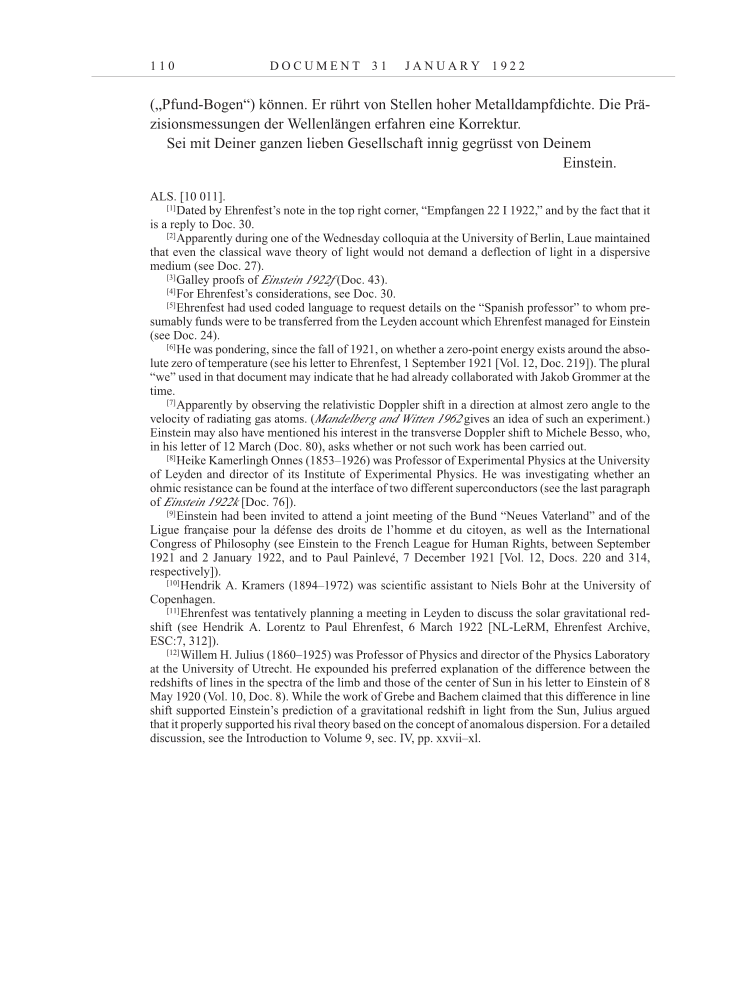1 1 0 D O C U M E N T 3 1 J A N U A R Y 1 9 2 2 („Pfund-Bogen“) können. Er rührt von Stellen hoher Metalldampfdichte. Die Prä- zisionsmessungen der Wellenlängen erfahren eine Korrektur. Sei mit Deiner ganzen lieben Gesellschaft innig gegrüsst von Deinem Einstein. ALS. [10 011]. [1]Dated by Ehrenfest’s note in the top right corner, “Empfangen 22 I 1922,” and by the fact that it is a reply to Doc. 30. [2]Apparently during one of the Wednesday colloquia at the University of Berlin, Laue maintained that even the classical wave theory of light would not demand a deflection of light in a dispersive medium (see Doc. 27). [3]Galley proofs of Einstein 1922f (Doc. 43). [4]For Ehrenfest’s considerations, see Doc. 30. [5]Ehrenfest had used coded language to request details on the “Spanish professor” to whom pre- sumably funds were to be transferred from the Leyden account which Ehrenfest managed for Einstein (see Doc. 24). [6]He was pondering, since the fall of 1921, on whether a zero-point energy exists around the abso- lute zero of temperature (see his letter to Ehrenfest, 1 September 1921 [Vol. 12, Doc. 219]). The plural “we” used in that document may indicate that he had already collaborated with Jakob Grommer at the time. [7]Apparently by observing the relativistic Doppler shift in a direction at almost zero angle to the velocity of radiating gas atoms. (Mandelberg and Witten 1962 gives an idea of such an experiment.) Einstein may also have mentioned his interest in the transverse Doppler shift to Michele Besso, who, in his letter of 12 March (Doc. 80), asks whether or not such work has been carried out. [8]Heike Kamerlingh Onnes (1853–1926) was Professor of Experimental Physics at the University of Leyden and director of its Institute of Experimental Physics. He was investigating whether an ohmic resistance can be found at the interface of two different superconductors (see the last paragraph of Einstein 1922k [Doc. 76]). [9]Einstein had been invited to attend a joint meeting of the Bund “Neues Vaterland” and of the Ligue française pour la défense des droits de l’homme et du citoyen, as well as the International Congress of Philosophy (see Einstein to the French League for Human Rights, between September 1921 and 2 January 1922, and to Paul Painlevé, 7 December 1921 [Vol. 12, Docs. 220 and 314, respectively]). [10]Hendrik A. Kramers (1894–1972) was scientific assistant to Niels Bohr at the University of Copenhagen. [11]Ehrenfest was tentatively planning a meeting in Leyden to discuss the solar gravitational red- shift (see Hendrik A. Lorentz to Paul Ehrenfest, 6 March 1922 [NL-LeRM, Ehrenfest Archive, ESC:7, 312]). [12]Willem H. Julius (1860–1925) was Professor of Physics and director of the Physics Laboratory at the University of Utrecht. He expounded his preferred explanation of the difference between the redshifts of lines in the spectra of the limb and those of the center of Sun in his letter to Einstein of 8 May 1920 (Vol. 10, Doc. 8). While the work of Grebe and Bachem claimed that this difference in line shift supported Einstein’s prediction of a gravitational redshift in light from the Sun, Julius argued that it properly supported his rival theory based on the concept of anomalous dispersion. For a detailed discussion, see the Introduction to Volume 9, sec. IV, pp. xxvii–xl.
